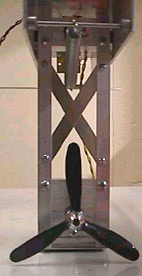

ES 101
ES 101 - Introduction to Engineering - in this introduction to engineering class I worked with three other people to create an emergency generator for a plane that looses power in flight. A number of techniques from the four major engineering fields were applied in the process of this project. Each of the four fields - Electrical, Civil and Environmental, Chemical, and Mechanical - was involved in some critical aspect of the project. Below are images of the final prototype.
 |
 |
Here is a photo of the circuit board. |
 |
| Here is a picture of the spring in place. |  |
Here is an image of the parts we machined for our project. |  |
| Here is an image of the analysis for the cross bracing. This design proved to be best for our project. |  |
Chemical engineering's focus on processes allowed us to make calculations critical to the spring selection and to our final data analysis. These aspects intertwined with graphical design techniques yielded the final product that worked within the required limits. A production scenario was also evaluated for this generator as economic factors had to be considered alongside the engineering aspects in the analysis. Our final project was considered a success and was able to power the required loads at various wind speeds.